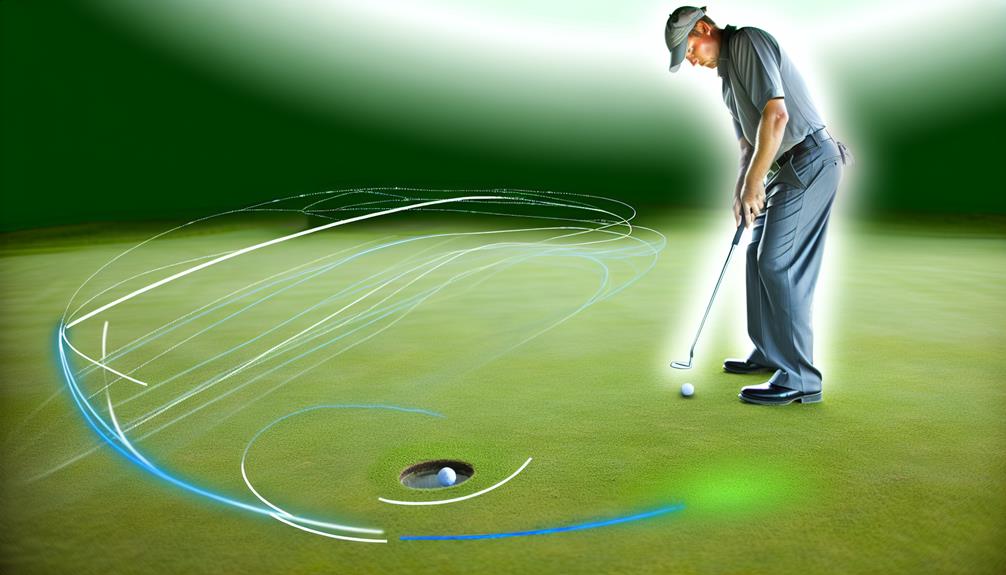Imagine the intense silence on the green, the sun beating down on your back as you line up your putter, the quiet hum of anticipation from the gallery.
You're just a stroke away from clinching the match, but your success hinges on your putting accuracy. You've been here before, haven't you? Frustrated by those missed putts, those agonising near-misses that cost you the game.
Well, it doesn't have to be that way. Let's explore five proven techniques that can transform your putting game, leaving those missed opportunities in the past.
Stay with me, and together, we'll turn those near-misses into certain victories.
Understanding Putting Basics
To elevate your golf game, you'll first need to grasp the fundamentals of putting, a crucial aspect that can make or break your performance. Understanding green slopes and choosing the right putter are two essential components of these basics.
Let's delve into the former. The slope of the green affects the path and speed of your ball. Reading these contours accurately can give you an edge. You should train your eyes to spot subtleties in the terrain and understand how these might alter the ball's trajectory. A downhill slope, for example, will quicken the ball's pace, while an uphill gradient will slow it down.
Next, your choice of putter is pivotal. It's not just about what feels comfortable in your hands; it's about what suits your style of play. A heavier putter head can be beneficial for slow, smooth strokes, while a lighter one might be better for a quicker stroke. Putters also come in different lengths, and the right fit can improve your stance and stroke consistency.
Mastering the Pendulum Stroke
Having grasped the basics of putting, you're now ready to tackle the art of the pendulum stroke, a skill that's as much about rhythm and timing as it's about precision. The pendulum stroke physics involve a back and forth motion, much like a pendulum's swing. This uniform motion ensures that the ball is struck at the same rate each time, enhancing your consistency and accuracy on the greens.
In mastering this technique, stroke tempo control is crucial. Aim for a steady, rhythmic motion; too fast, and your putts will veer off course, too slow, and they'll fall short. To accomplish this, you need to maintain an even tempo throughout your stroke. Imagine the ticking of a clock or a metronome. Your backstroke and forward stroke should match this rhythm.
It's also essential to keep your body still during the stroke. Any unnecessary movement can interfere with the pendulum motion and throw off your accuracy. Practice maintaining a stable stance and focus on moving only your shoulders.
Importance of Aiming Correctly
Now let's delve into the crucial aspect of correct aiming, an often-underestimated factor that can significantly impact your putting accuracy in golf. Aiming correctly isn't merely about pointing your club towards the hole; it's an intricate process involving eye alignment and visual perception.
Through proper eye alignment, you're essentially lining up your eyes parallel to the target line. This alignment is vital for your visual perception and helps you see the line of the putt accurately, playing a significant role in directing your stroke. If you're misaligned, the chances are that you'll send the ball off-course, no matter how well you've hit it.
Furthermore, your visual perception plays a significant role in correct aiming. How you perceive the line between the ball and the hole affects your stroke. That's why it's essential to focus on 'seeing' the line correctly. One useful technique you can employ is visualizing the ball's path to the hole before making your stroke. This mental image can greatly assist in aiming accurately.
Perfecting Your Grip Technique
While correct aiming and visual perception substantially enhance your putting accuracy, mastering your grip technique is equally pivotal, given its direct influence on the control and direction of your golf stroke.
Grip pressure control is a key component of an effective grip technique. You should apply a firm, yet relaxed, grip. Too much pressure can cause your stroke to be rigid and uncontrolled, while too little can lead to a weak and inconsistent hit. Experiment with different levels of grip pressure until you find the sweet spot that offers you maximum control without compromising your stroke fluidity.
Furthermore, hand position variations can also impact your putting accuracy. Traditionally, golfers utilize an overlap or interlock grip, but it's crucial to understand that what works for one player may not work for you. For instance, if you have smaller hands, you might find a ten-finger grip more comfortable and effective. If you're battling with a slice, a strong grip could help neutralize the ball flight.
Implementing Consistent Practice Routines
Incorporating consistent practice routines into your golf regimen, you'll find that your putting accuracy improves over time. The key is to establish a routine that works for you and stick to it.
Mental preparation plays a crucial role in this. Before you even step onto the green, envision your putt. Picture the ball's path, the impact of your swing, and the satisfying drop into the hole. This mental exercise not only primes you for success but also contributes to your overall focus and calm on the course.
Next, consider routine analysis. Look back on your practice sessions. What worked? What didn't? Be honest with yourself about your strengths and weaknesses. If your putts consistently veer to the left, incorporate targeted drills to correct this in your routine.
Consistency is paramount. It's better to practice for a shorter period every day than for several hours once a week. This regularity reinforces muscle memory and hones your skills more effectively.

